
* The Hawker Sea Hawk, while not the first naval shipboard jet fighter, was an early example of its type that incorporated several ingenious engineering features and was an extremely clean design. It provided excellent service as a first-line fighter in several air arms for over a decade. A list of illustrations credits is included at the end.

* While Hawker Aircraft was introducing their Fury prop-driven fighter in 1944, Hawker engineers began to consider how to apply the new jet engine technology to the Fury design. Rolls-Royce had just introduced a new centrifugal-flow turbojet engine, the B.41, to be named the "Nene", that had adequate thrust to propel the big Fury airframe. In November 1944, Hawker submitted a preliminary concept for a B.41-powered Fury to the British government, with the designation "P.1035".
The design team, working under Hawker's Sydney Camm, removed the piston engine from the nose of the Fury, moved the bubble canopy as far forward as possible, and put the B.41 engine in the middle of the aircraft. The intakes were positioned alongside the fuselage, and the tailpipe went straight out the back.
After a little more thought, the Hawker engineers came up with a follow-on proposal in December 1944. The new design, designated the "P.1040", had a significant change, the straight tailpipe being replaced with a split tailpipe, with an outlet in each wing root. This scheme meant the wing root had to be thickened, and so the intakes were placed in the wing roots as well. This new layout reduced the length of the of ducting and allowed fuel to be stored both fore and aft of the engine, preserving the aircraft's center of gravity as fuel was consumed. It also reduced the thrust losses that would be caused by longer exhaust pipes.
The Fury's distinctive elliptical wing was abandoned for one with straight edges to simplify manufacturing, and the tailplane was raised to clear the jet exhaust. The new design was the first Hawker aircraft with tricycle landing gear. With all the changes, the P.1040 no longer looked at all like a Fury. Armament was specified as four Hispano Mark 5 20-millimeter cannon. The P.1040 was intended for Royal Air Force (RAF) use, but government interest was mild. The war would clearly be over before long, and both the RAF and the Royal Navy had other jet fighter designs either flying or in the works. Nonetheless, in October 1945, months after the guns had gone silent, Camm ordered the construction of a P.1040 prototype.
By that time, RAF interest had gone completely to zero; RAF planners believed that their new 950 KPH (600 MPH) Meteor would be the hottest thing in the air for the foreseeable future. Hawker Aircraft, faced with massive cancellations of orders for their piston fighters, hastily modified the P.1040 design for carrier operation, and submitted the proposal to the Royal Navy in January 1946. Much to Hawker's relief, the Royal Navy was impressed and ordered three prototypes, plus a static test item. Hawker completed the prototype already in progress to provide the initial aircraft, and quickly constructed the others. Camm's engineers then proceeded to refine the P.1040's design as a carrier-based interceptor. They also considered what could be done to get the RAF interested again, an effort that eventually led to the extremely successful Hawker Hunter.
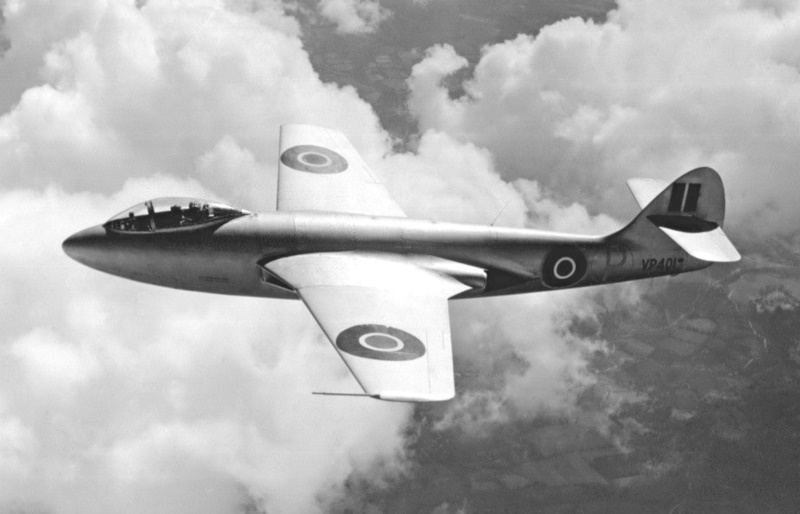
The first prototype of the P.1040 flew on 2 September 1947, powered by a Nene 1 engine, with 20.02 kN (2,040 kgp / 4,500 lbf) thrust. The project was announced to the public a month later, disguised for some forgotten reason as a purely company-financed effort. This pretense was dropped when the second prototype flew a year later, on 3 September 1948. The second prototype had folding wings, a stinger-type arresting hook, and was fully armed. The second prototype was used in carrier trials that indicated a need for a slightly wider wingspan and longer arresting hook.
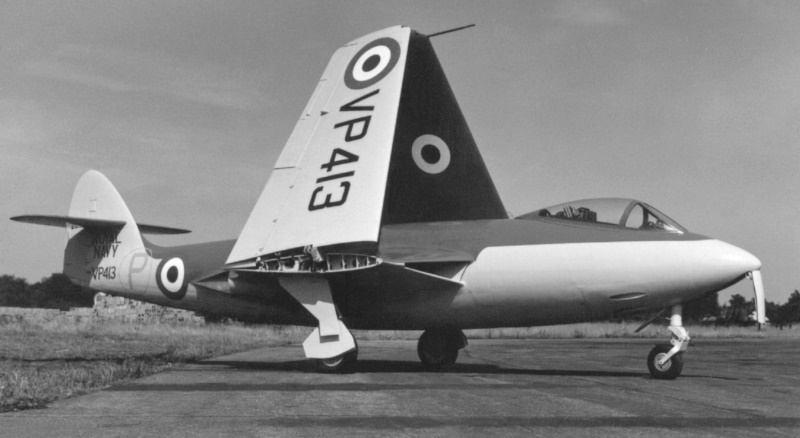
The third prototype took to the air on 17 October 1949. This aircraft was essentially a fully-functional production prototype, with longer arresting hook, provisions for "Rocket Assisted Take-Off Gear (RATOG)", and attachment points for drop tanks. The powerplant was production-standard Rolls-Royce Nene 2 / RN.4 Nene 101, with 22.27 kN (2,270 kgp / 5,000 lbf) thrust. Service trials proved successful; on 22 November 1949, the Royal Navy ordered 151 examples of the new aircraft, now formally known as the "Sea Hawk".
BACK_TO_TOP* The initial batch of 35 Sea Hawk "Fighter Mark 1s (F.1)" was partly used for further service trials -- one of which ended disastrously when the aircraft's folding wings unlocked on take-off -- and to provide the first examples actually delivered to Royal Navy Fleet Air Arm (FAA) squadrons in March 1953.
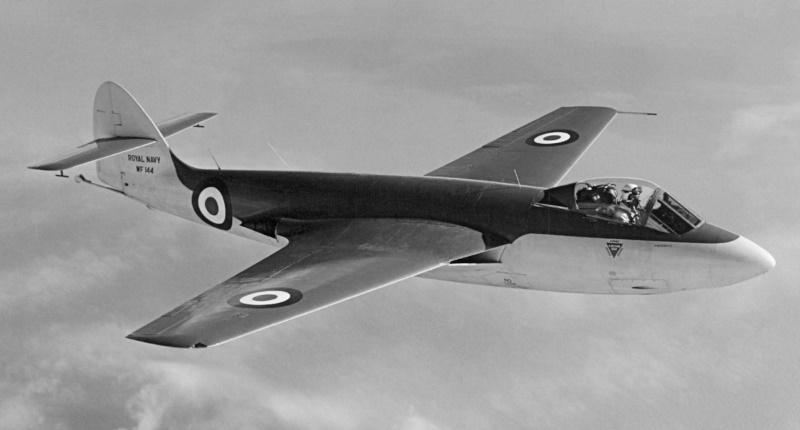
When Winston Churchill became prime minister again in 1951, he initiated a "Super-Priority" scheme to speed the production of certain critical aircraft, including the Sea Hawk. The end result was that manufacturing was transferred to Armstrong Whitworth Aircraft (AWA), another member of the Hawker Siddeley group. AWA built 60 more Mark 1s. Pilots had noticed a tendency for the ailerons to oscillate; to fix this problem, the Sea Hawk "F.2" was produced by AWA, providing power-actuated ailerons and a few other small improvements. 40 were built.

The next variant, the Sea Hawk "Fighter-Bomber Mark 3 (FB.3)", first flew in March 1954. It incorporated a strengthened wing that could be adapted to carry a variety of stores. Test configurations included two 225-kilogram (500-pound) bombs and dual drop tanks; 20 "sixty pounder" rocket projectiles (RP), which were 7.62-centimeter (3-inch) rockets, each with a 27-kilogram (60-pound) warhead; and other combinations of bombs, rockets, or mines. 116 Mark 3s were built, but the Royal Navy was so overloaded with Korean War commitments that the service was unable to qualify most of these aircraft for full use of stores. Despite the holdups with the FB.3, an improved strike variant, the Sea Hawk "Fighter Ground-Attack Mark 4 (FGA.4)", was developed, being first flown in August 1954, with 97 were built in all.
By 1954, however, other nations were beginning to field aircraft that could break the sound barrier in level flight, and the performance of the Sea Hawk was becoming inadequate. The Rolls-Royce Nene was a centrifugal-flow engine, and it had become obvious by that time that this was a technological dead end for high-performance aircraft. The axial-flow engine was clearly the way of the future.
Some improvements were still possible. When the 24.13 kN (2,460 kgp / 5,200 lbf) thrust RN.4 Nene 103 became available, about 50 FB.3s were re-engined with the Nene 103, becoming known as Sea Hawk "FB.5s" (referred to in some sources as "F.5s", though that seems inconsistent). The increase in thrust was too small to significantly increase the aircraft's top speed, but it did provide an additional margin of safety for flight-deck operations.
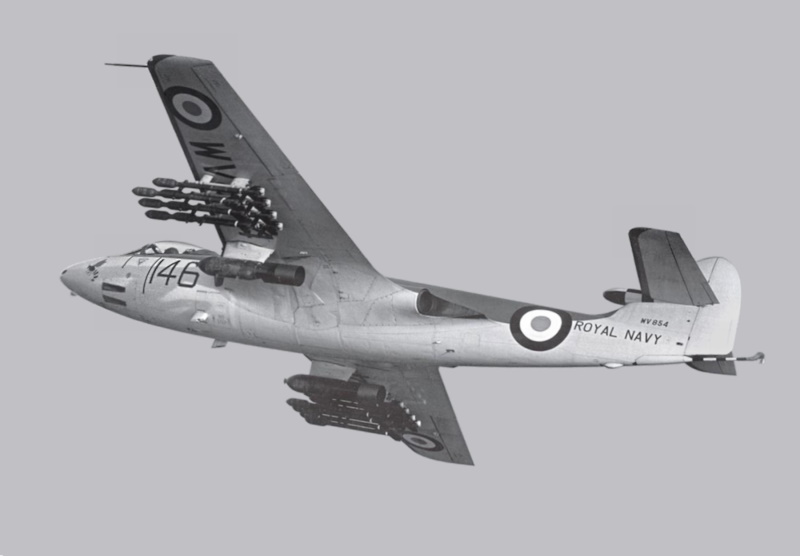
The new Nene 103 was also engineered into new-build Sea Hawks. These new machines being designated the "FGA.6", and 87 were built for the FAA. A number of FGA.4s were upgraded to FGA.6 standard as well.
___________________________________________________________________
HAWKER SEA HAWK FGA.6:
___________________________________________________________________
wingspan:
11.89 meters (39 feet)
wing area:
25.83 sq_meters (278 sq_feet)
length:
12.09 meters (39 feet 8 inches)
height:
2.64 meters (8 feet 8 inches)
empty weight:
4,208 kilograms (9,728 pounds)
max loaded weight:
7,327 kilograms (16,153 pounds)
maximum speed:
901 KPH (560 MPH / 487 KT)
service ceiling:
13,565 meters (44,500 feet)
range (no drop tanks):
770 kilometers (480 MI / 420 NMI)
range (drop tanks):
1,270 kilometers (790 MI / 685 NMI)
___________________________________________________________________
The FGA.6 was the first variant of the Sea Hawk to see combat action, providing close air support for the Anglo-Israeli-French seizure of the Suez Canal, Operation MUSKETEER, in November 1956. The aircraft flew from the carriers HMS ALBION, BULWARK, and EAGLE. The Sea Hawks acquitted themselves well, but two were lost due to Egyptian ground fire and several others were damaged. Overall, MUSKETEER was a military success but a political disaster, with the Americans intervening to demand that the invaders withdraw.
By that time, the Sea Hawk was on the verge of obsolescence, and phasing-out of the type began in 1958. By 1960, it was completely out of FAA first-line service.
BACK_TO_TOP* The FGA.6 was the basis for minor variants supplied to the Netherlands and to West Germany. In 1956, 30 "Mark 50" Sea Hawks were ordered by the Dutch, to be paid for with NATO funds. These machines were almost identical to FGA.6 aircraft, but had a Philips UHF radio, with a large blade antenna on the top of the aircraft. Most of these machines were later modified to carry a pair of Philco-Ford Sidewinder 1A heat-seeking air-to-air missiles. These aircraft remained in service until 1964.
At about the same time, the West German Navy air arm, the "MarineFlieger", placed an order for 64 Sea Hawks, with the order evenly split between 32 day fighters and 32 foul-weather fighters. The machines delivered were also basically FGA.6 aircraft, but with a tailfin about 38 centimeters (15 inches) taller. The day fighters were designated "Mark 100". The foul-weather fighters were designated "Mark 101", and carried a large pod with an Ekco Type 34 search radar on one of the underwing pylons.
The last production Sea Hawks were 14 FGA.6 aircraft, delivered in 1961 to the Indian Navy, along with 10 refurbished ex-FAA machines. (Sources tend to vary on the relative numbers of used versus refurbished machines in this batch, and it appears to be one of those little things that will likely never be straightened out.) Along with the initial purchase batch, India also obtained 12 ex-FAA Sea Hawks from Britain and 28 used machines from Germany, with the last Sea Hawks delivered to India in 1965 for a total of 74 aircraft.
Indian Sea Hawks saw combat during the 1971 Indo-Pakistan war, performing strikes off the carrier INS VIKRANT on the Pakistani port of Chittagong and other coastal targets. The Sea Hawks inflicted substantial damage and suffered no losses to themselves. That was the second and final time the Sea Hawk was used in anger.
An Indian Navy pilot, Commander Peter Debras, accomplished an extraordinary feat on 4 March 1976, when the VIKRANT's catapult malfunctioned and his Sea Hawk splashed down and sank in front of the carrier. The vessel then steamed directly over the top of the aircraft; Debras coolly waited until it had passed over before punching out and being rescued. It was the world's deepest successful ejection.
The Indians would continue to operate their Sea Hawks until the early 1980s, when these aircraft were replaced by Hawker Sea Harriers. Several of the Indian aircraft survive as static museum displays and gate guards. One FGA.6, tailcode WV908, was restored to flight status in 1998; it has flown intermittently since then, sometimes being grounded due to damage or lack of funds, but at last notice she was still taking to the air.
BACK_TO_TOP* A total of 547 Sea Hawks was built in all. Variants included:
FGA.6 total includes 87 for the FAA and 14 for India. India also obtained 22 ex-FAA and 28 ex-West German Sea Hawks, for a total of 74. The total does not include a number of FGA.4s that were upgraded to FGA.6 standard.
* If the Sea Hawk wasn't one of aviation history's greatest aircraft, it wasn't an embarrassment, either. Conceived in 1944, with last production in 1961 and 547 aircraft delivered, it served useful and reliable duty for a number of naval air arms. Its clean and elegant design would eventually evolve into the Hawker Hunter, one of the major fighters of the 1950s.
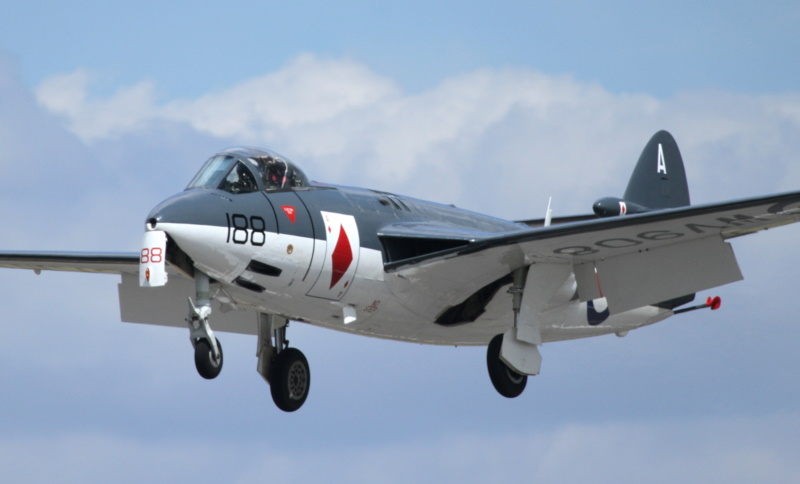
I had never really heard of the Sea Hawk until the 1990s. Certainly I must have seen it in books when I was younger, but never paid any attention to it. However, I've acquired a fascination with the first generation of jet fighters. A lot of ingenuity was applied with the development of the new jet technology, and many of the aircraft had a certain cleanliness and simplicity, thoroughly manifested in the elegant Sea Hawk, that would be lost as the aircraft became more sophisticated.
* Sources for this document include:
Some details in the v1.2 revision were obtained from Damien Burke's THUNDER & LIGHTNINGS site in the UK.
* Illustrations details:
* Revision history:
v1.0 / 15 oct 96 v1.1 / 25 may 99 / Review & polish. v1.2 / 01 oct 00 / New illustrations, minor changes. v1.0.3 / 01 dec 01 / New illustrations & cosmetic changes. v1.0.4 / 01 nov 03 / Review & polish. v1.0.5 / 01 aug 04 / Various small tweaks. v1.0.6 / 01 jul 06 / Review & polish. v1.0.7 / 01 mar 08 / Review & polish. v1.0.8 / 01 oct 09 / Seahawk returned to flight. v1.0.9 / 01 sep 11 / Review & polish. v1.1.0 / 01 may 12 / Review & polish, illustration update. v1.1.1 / 01 apr 14 / Review & polish. v1.1.2 / 01 jul 14 / Review & polish. v1.1.3 / 01 jun 16 / Review & polish. v1.1.4 / 01 may 18 / Review & polish. v1.2.0 / 01 apr 20 / Illustrations update. v1.2.1 / 01 feb 22 / Review & polish. v1.2.2 / 01 jan 24 / Review & polish.BACK_TO_TOP
